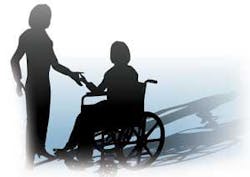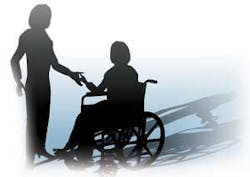Disabilities: Dealing with an injury
null
by Ann-Marie DePalma, CDA, RDH, MEd, FAADH
Imagine starting a new job, and while performing part of your job, you fall and injure yourself and need an ambulance ride to the hospital! You are diagnosed with a fractured ankle, and you will be required to stay off your foot and use crutches for six weeks. Among your many thoughts, how will you get around and continue to work? What accommodations are there for you to work or perform everyday tasks while you recover? Is your office compliant with the Americans with Disabilities Act? This is exactly what happened to me when I recently began a new position and was faced with the challenges of immobility.
First, since I was injured at work, my employer was very supportive. He called to check on me the day of my accident and had information I needed to complete my insurance information. Injuries at work are covered under worker’s compensation (worker’s comp). Workers’ compensation laws were enacted to reduce the need for lawsuits by injured workers. The first state to enact a worker’s comp law was Maryland in 1902, and the first law to cover federal employees was passed in 1906. By 1949, all states had enacted some kind of worker’s compensation benefits. Initially called “workman’s&rdquo: compensation, today it is referred to as the gender neutral “worker’s&rdquo: compensation. Employees who are injured on the job have the right to medical care following an injury, and often to monetary payments for temporary or permanent disability.
Employers are required to provide insurance for worker’s compensation. This information should be posted in a prominent place in the workplace. If an employer illegally does not provide the insurance, there is a public fund that can be used by the employee. Most states’ workers’ compensation is provided by private insurance companies, although 12 states operate a separate state fund. (Maine uses a private insurer; thus my claim was through a private insurance company.) It is illegal for any employer to terminate or refuse to hire an employee for reporting a workplace injury or filing a workers’ compensation claim. Luckily, my employer was very good about allowing me time for doctors’ appointments and compensation. Other employers may not be so honorable. Some workers have claims that are contested, and therefore legal issues ensue. But it is a two-way street. The amount of time a worker is out of work must be proportional to the severity of the disability.
The Americans with Disabilities Act
Since I was limited in my ability to walk and crutches and I didn’t get along, I chose to borrow a wheelchair for a short time. Using the wheelchair was a challenging experience, and it made me realize there are many obstacles for those who are permanently disabled. The Americans with Disabilities Act of 1990, signed by President George H.W. Bush, expands the civil rights protection of the Civil Rights Act of 1964 to protect those with disabilities. A disability is defined as a physical or mental impairment that limits major life activities. The act is constantly being revisited and updated. Several amendments were made in 2008 that became active on January 1, 2009, and allowed for broader protection for disabled workers.
Under the Act, no individual can be denied access to facilities or education based on disabilities. Whether newly constructed or existing facilities, equal access to all facilities must be provided for all. There are several exceptions to this, but these must be provided within the maximum extent feasible. Older facilities can be “grandfathered&rdquo: in providing accessibility, but it must be provided for in the most feasible manner.
Since I’m working in a new facility, everything is built up to code. Doorways are wide enough to accommodate wheelchair access, elevators have handicap accessibility, Braille markings designate rooms, and restrooms are handicapped accessible. My boss even joked that I was a great test case for ADA accessibility — if I could get around in the wheelchair, things were good. The floors are hardwood, so getting from one area to another was actually fun. I could get a good rolling start in the wheelchair! However, the door to the ladies room presented a challenge. There is no push-to-open button, so I had to get up in the wheelchair and often felt the chair tip slightly when I needed to open the door. That made me realize how difficult it must be for the disabled to get in and out of a variety of situations.
Outside of work is where I felt the accessibility issue the most. Many areas are not disability friendly. Sidewalks can be challenging, stores place sale items in aisles, and many things that most people take for granted are daunting. When I was able, I moved from the wheelchair to a walking boot. The boot allowed me more freedom, but I often felt as if someone might step on my foot. Since the injury was of my right foot, I was unable to drive and became very dependent on others (especially my husband) to get back and forth to work or do other activities.
But some good things happened as well. My family and I had tickets to a Red Sox game several weeks after the accident. I was concerned I couldn’t make it to the seats at Fenway Park because it required climbing stairs, but I spoke with ticket representatives and was offered accessible seating, which actually proved to be better than the seats we had! So something good came from what was a very frustrating experience!
At a recent dental hygiene educational conference, I talked with Betsy Reynolds, RDH, MS, about the difficulties of being disabled. Betsy was also suffering a disability from a fall where she injured both wrists that required surgery. She and I compared notes about the struggles facing the disabled. Although both our injuries would heal, we agreed that being disabled, even for a short period of time, can be devastating and life-altering.
So many things we take for granted are major challenges for those who are disabled. As dental professionals, we need to understand and appreciate the difficulties that disabled patients experience. From holding a toothbrush to other personal care issues, to getting from place to place, disabled patients are constantly confronted with obstacles. As dental professionals we need to think outside the box in providing oral health education and treatment to disabled patients who seek our care. Understanding their needs can be an eye-opening and humbling experience.
Author’s note: I am about three months post-fall and am seeing a physical therapist to increase ankle mobility and range of motion. There is still some swelling present. An orthopedic surgeon has recommended continuing PT and waiting a few months to see if swelling decreases before proceeding with further treatment.
About the Author
Ann-Marie C. DePalma, RDH, MEd, FAADH, is a Fellow of the American Academy of Dental Hygiene and a member of ADHA and other professional associations. Ann-Marie presents continuing-education programs for hygienists and dental team members and has written numerous articles on a variety of topics. She can be reached at [email protected].

